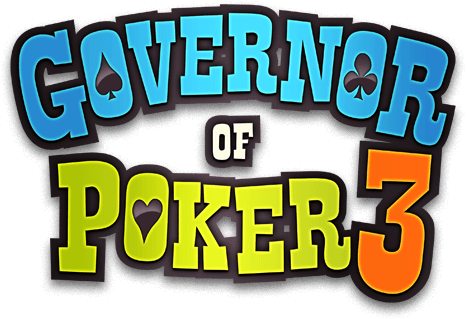Video and online gaming is a widely enjoyed activity that can serve as a valuable tool for coping with life's challenges, offering an escape from overwhelming circumstances. While the stereotype of the avid gamer may suggest a socially isolated individual, gaming often fosters communal experiences. Research by Yee (2006) identifies three primary motivations for engaging in gaming: achievement (the pursuit of power and symbols of status within the game), social interaction (the desire for teamwork and social support), and immersion (the exploration of new information and the ability to role-play and customize one's persona). Additionally, gaming has been shown to enhance cognitive function and facilitate social connections.
This review outlines the background, methodology, results, and recommendations from a heuristic evaluation of the online social game Governor of Poker 3 (GOP3). The evaluation employed four modules—usability, playability, accessibility, and sociality—encompassing a total of 57 heuristics. Usability is defined as “the degree to which a player is able to learn, control, and understand a game” (Pinelle et al., 2008). Playability combines usability and gameplay aspects, representing both designed and programmable features of the game (Paavilainen et al., 2008). Accessibility pertains to elements that ensure the game is usable by all potential players, while sociability addresses the social dynamics embedded within the game (Amaro et al., 2016). By utilizing these heuristic principles, this review aims to assess the effectiveness of GOP3.
With the exception of accessibility, the review results indicated that most heuristics were validated for usability. However, three critical issues emerged regarding the inability to adjust the interface. To fully immerse oneself in a game, players must have comprehensive access to the game environment. A well-designed user interface offers numerous advantages and serves as the game's most effective tool for attracting and retaining players.
Background & Methodology
Background
Governor of Poker 3 is an engaging multiplayer social poker game that offers a rewarding progression system. Players begin their journey as a cowboy rookie at Beginners Lake and work their way up to high roller status and ultimately VIP+, aiming to amass over 20 billion chips and compete in high-stakes Western games at the Billionaires Saloon on The Strip.
The game features a variety of welcome packages and offers seven different poker formats, including cash games, Sit & Go tournaments, Spin & Play, Heads Up Challenge, and both No Limit and Pot Limit games. Players can join poker teams for collaborative rewards, compete against others, and enjoy classic blackjack.
In addition to poker, the game includes missions that yield rewards, as well as achievements like rings, badges, and trophies to showcase your accomplishments. Communication is seamless, with chat options and animated emoticons that can be used to bluff or taunt opponents.
Governor of Poker 3 can be played on mobile devices, tablets, laptops, and desktops, making it easy to enjoy wherever you are. Overall, it's a fun and immersive experience for both casual players and serious poker enthusiasts.
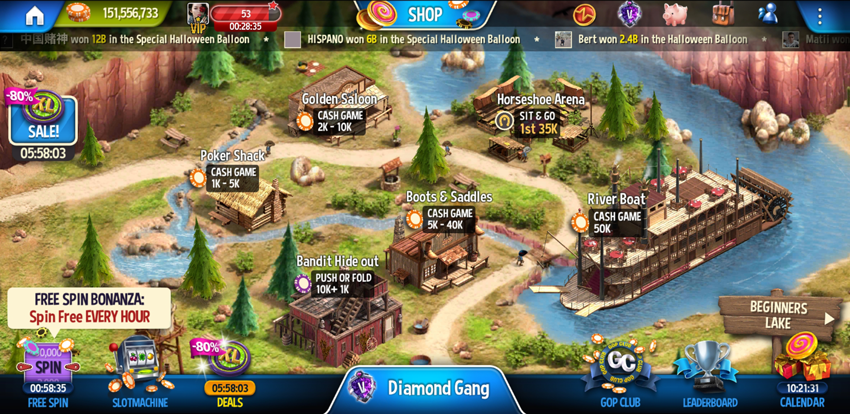
Figure 1. GOP3's Beginners Lake
Methodology
This review employed a set of four heuristics—Usability, Playability, Accessibility, and Sociability—derived from a paper presented at the International Conference on Technology and Innovation in Sports, Health, and Wellbeing at UTAD in Vila Real, Portugal (Amaro et al., 2016).
Table 1. Description of Usability, Playability, Accessibility, and Sociability Heuristics

Results
Heuristic Evaluation
The results were recorded using checklists and pie charts for each of the four module categories. Each heuristic was marked as verified or refuted with "Yes" or "No" options, while a third option, "NA," was used for questions not relevant to the game (see Tables 2–5 and Fig. 1). Additionally, a severity scale was implemented to prioritize resource allocation for addressing the most critical issues and to estimate the need for further efforts (see Table 6).
Table 2. Checklist for Usability Heuristics

Table 3. Checklist for Playability Heuristics

Table 4. Checklist for Accessibility Heuristics

Table 5. Checklist for Sociability Heuristics


Figure 2. Part-to-whole relationship of the checklist results for each category.
Table 6. Severity Scale
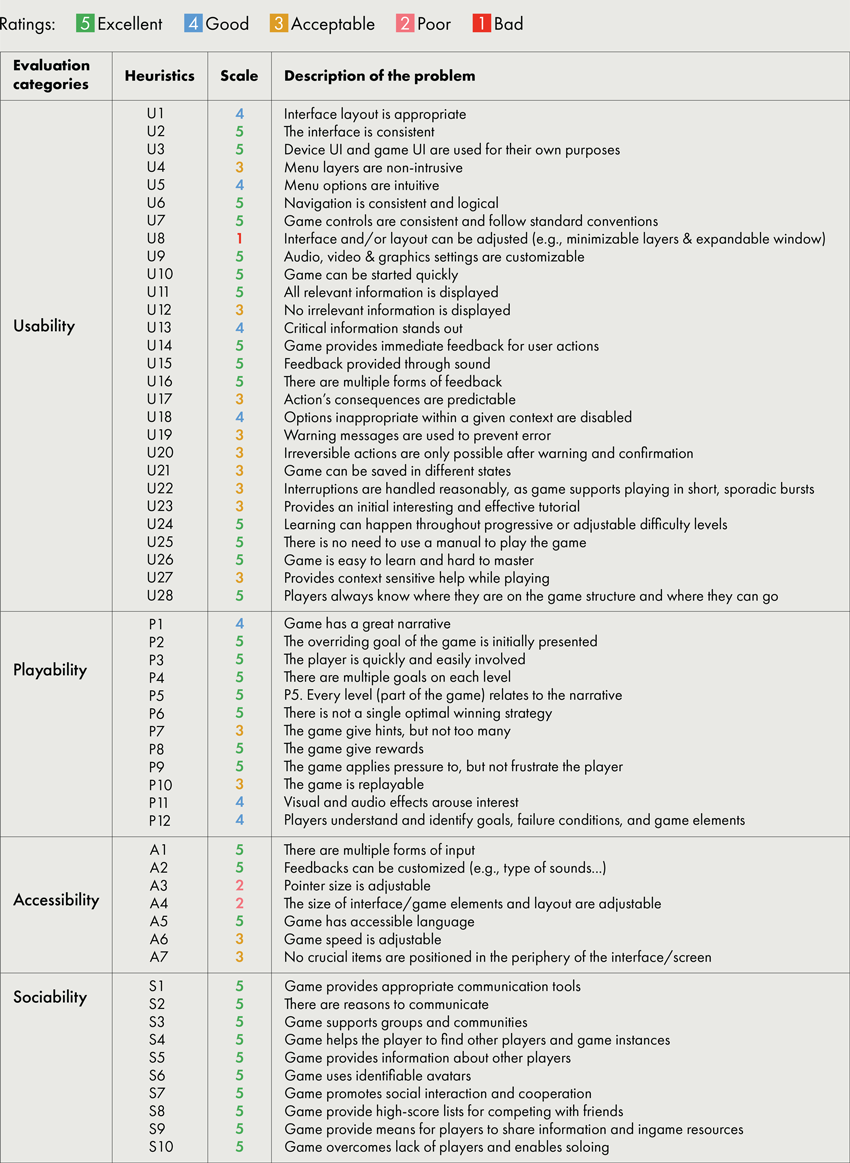
Usability Heuristics
It can be observed from Table 2, Figure 2, and Table 6 that most heuristics were verified for usability, with the exception of heuristic U8: “Interface and/or layout cannot be adjusted,” such as the inability to expand the game window. Table 2 also indicates that heuristic U27 is marked with a red checkmark for not providing "context-sensitive help while playing." However, this is not a concern, as receiving help during poker gameplay is generally irrelevant, so such assistance should not be necessary.
Playability Heuristics
Table 3, Figure 2, and Table 6 indicate that most heuristics for playability were verified, with the exception of heuristic P10: "the game is not replayable." However, this is not relevant to the rules of poker.
Accessibility Heuristics
The results for the accessibility heuristics in Table 4, Figure 2, and Table 6 highlight the biggest concerns for GOP3, with two out of seven heuristics receiving poor ratings. Heuristics A3 and A4 indicate that the pointer size and interface/game elements are non-adjustable.
Sociability Heuristics
GOP3 excelled in the sociability heuristics, achieving perfect scores as shown in Table 5, Figure 2, and Table 6. Figure 3 below illustrates the reasons why this game is considered sociable.
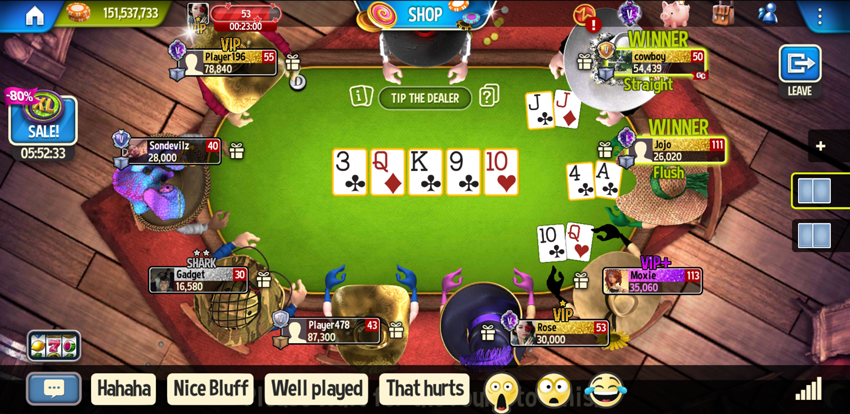
Figure 3. A game in the High Rollers Valley’s Red Rock Saloon.
Overview of Recommendation and Impact
Below are suggestions based on the findings with poor and bad ratings from the Severity Scale (Table 7).
Levels of impact:
- High – may prevent the user from completing a task or accessing information
- Moderate – might cause the user difficulty but the task could be completed
- Low – minor problems that would not significantly affect task completion
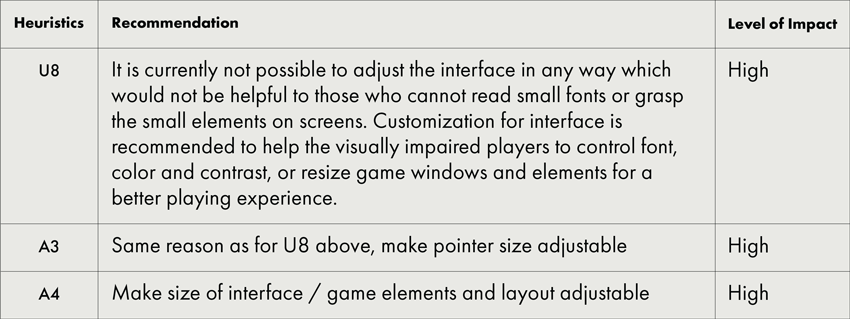
Reflection
The 4-module heuristic evaluation identified issues with individual elements and their impact on the overall user experience of GOP3. Given its nature as a social game, the heuristic set focused on usability, playability, accessibility, and sociability. The results indicated strong scores for usability, playability, and sociability, but highlighted the need for improvements in accessibility. Enhancing the interface to be adjustable would significantly enhance the gaming experience, as user interface and experience are crucial factors in a game’s success.
References
Amaro, A. C., Veloso, A. I., & Oliveira, L. (2016, December). Social games and different generations: A heuristic evaluation of Candy Crush Saga [Paper presentation]. TISHW – International Conference on Technology and Innovation in Sports, Health and Wellbeing. doi: 10.1109/TISHW.2016.7847791
Paavilainen, J., Korhonen, H., Koskinen, E., & Alha, K. (2018). Heuristic evaluation of playability: Examples from Social Games Research and Free-to-Play Heuristics. Oxford University Press. doi:10.1093/oso/9780198794844.003.001
Pinelle, D., Wong, N., & Stach, T. (2008, April 5-10). Heuristic evaluation for games: Usability principles for video game design [Paper presentation]. Proceeding of the twenty-sixth annual CHI conference. doi: 10.1145/1357054.1357282
Yee, N. (2006). Motivations for Play in Online Games. CyberPsychology & Behavior, 9(6), 772-775. http://doi.org/10.1089/cpb.2006.9.772
